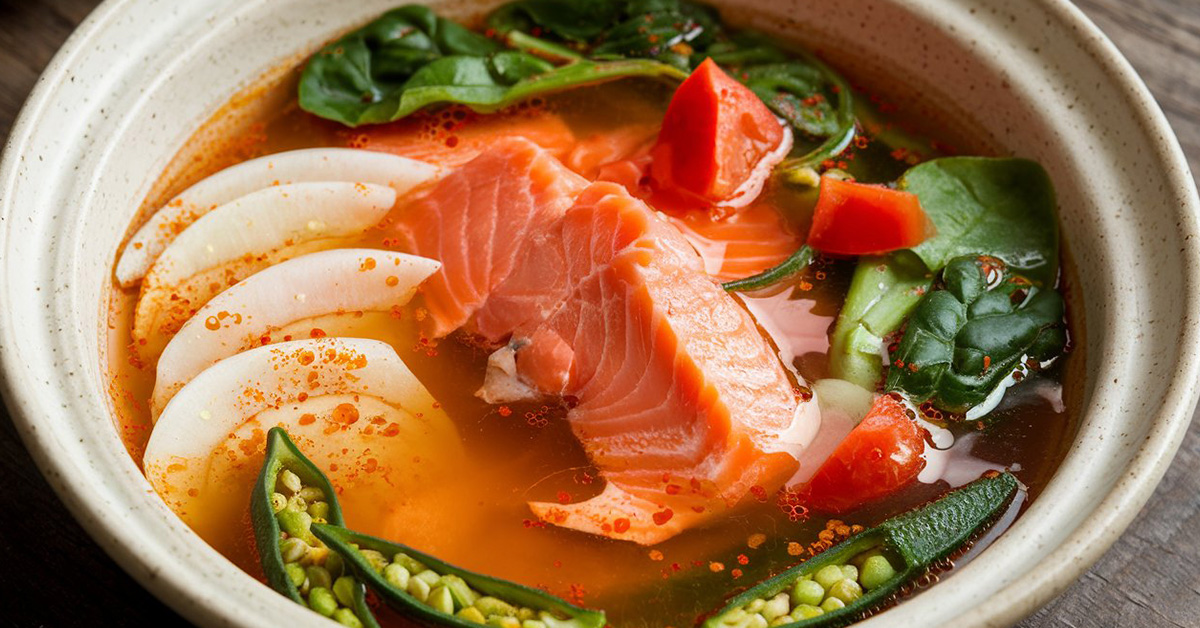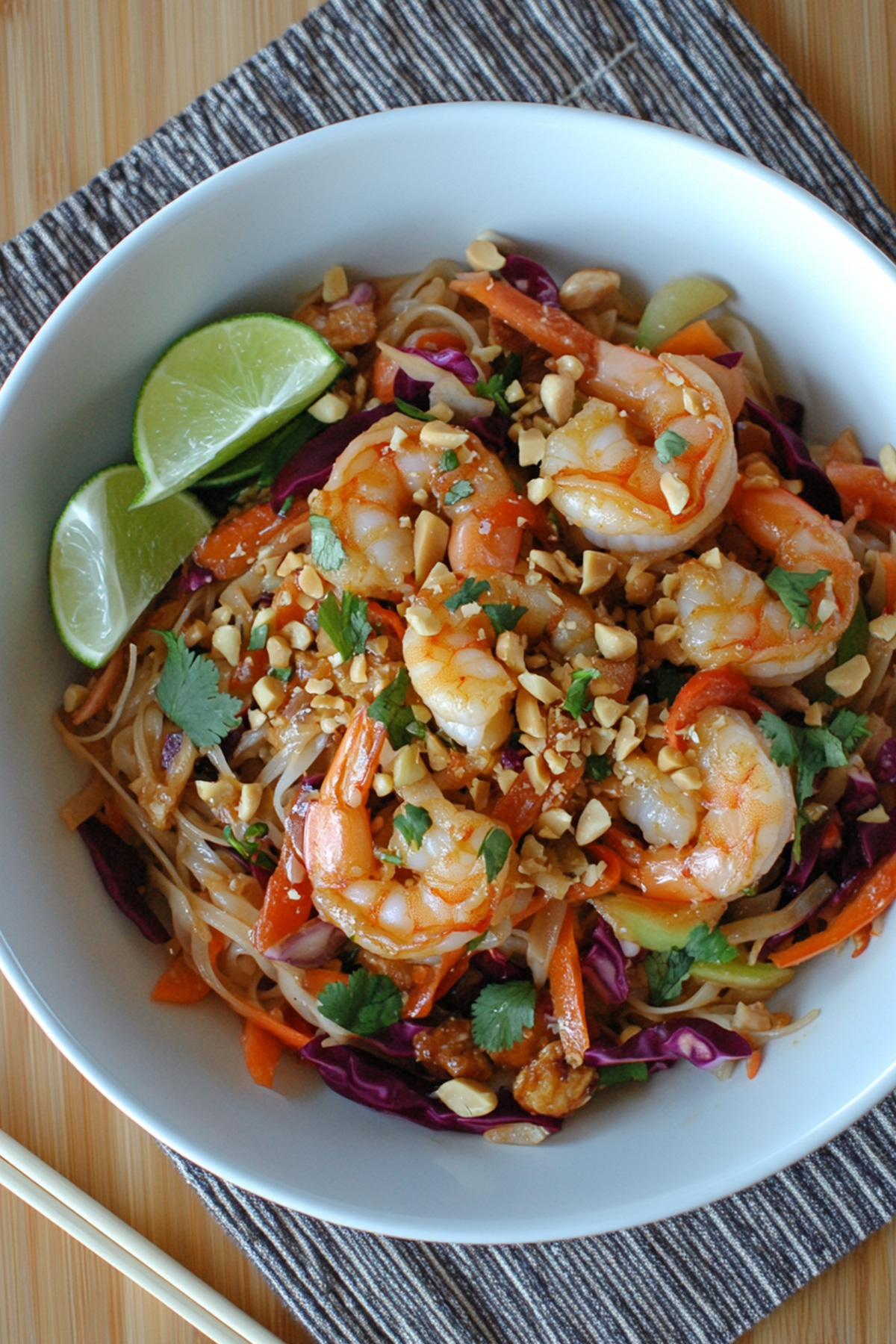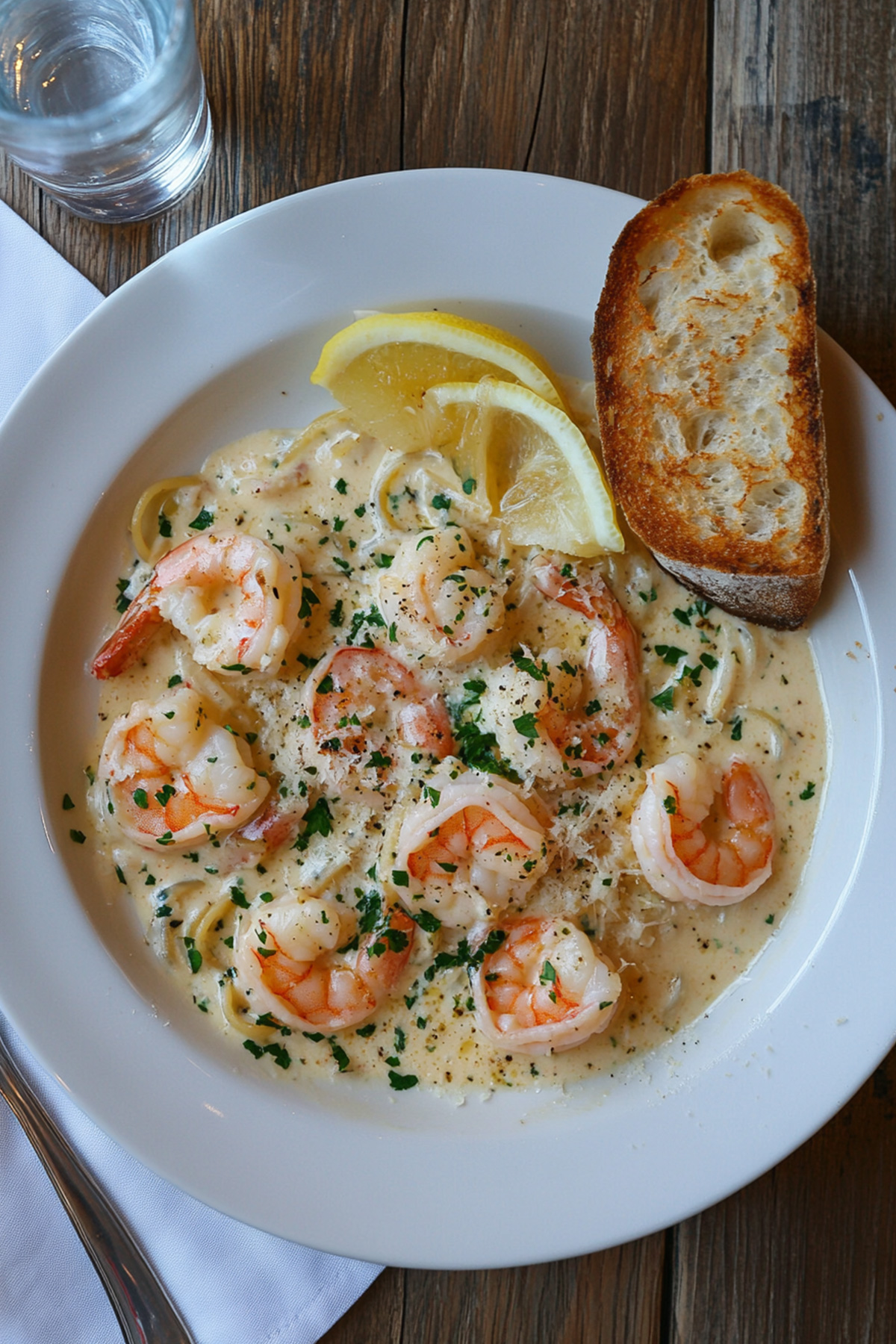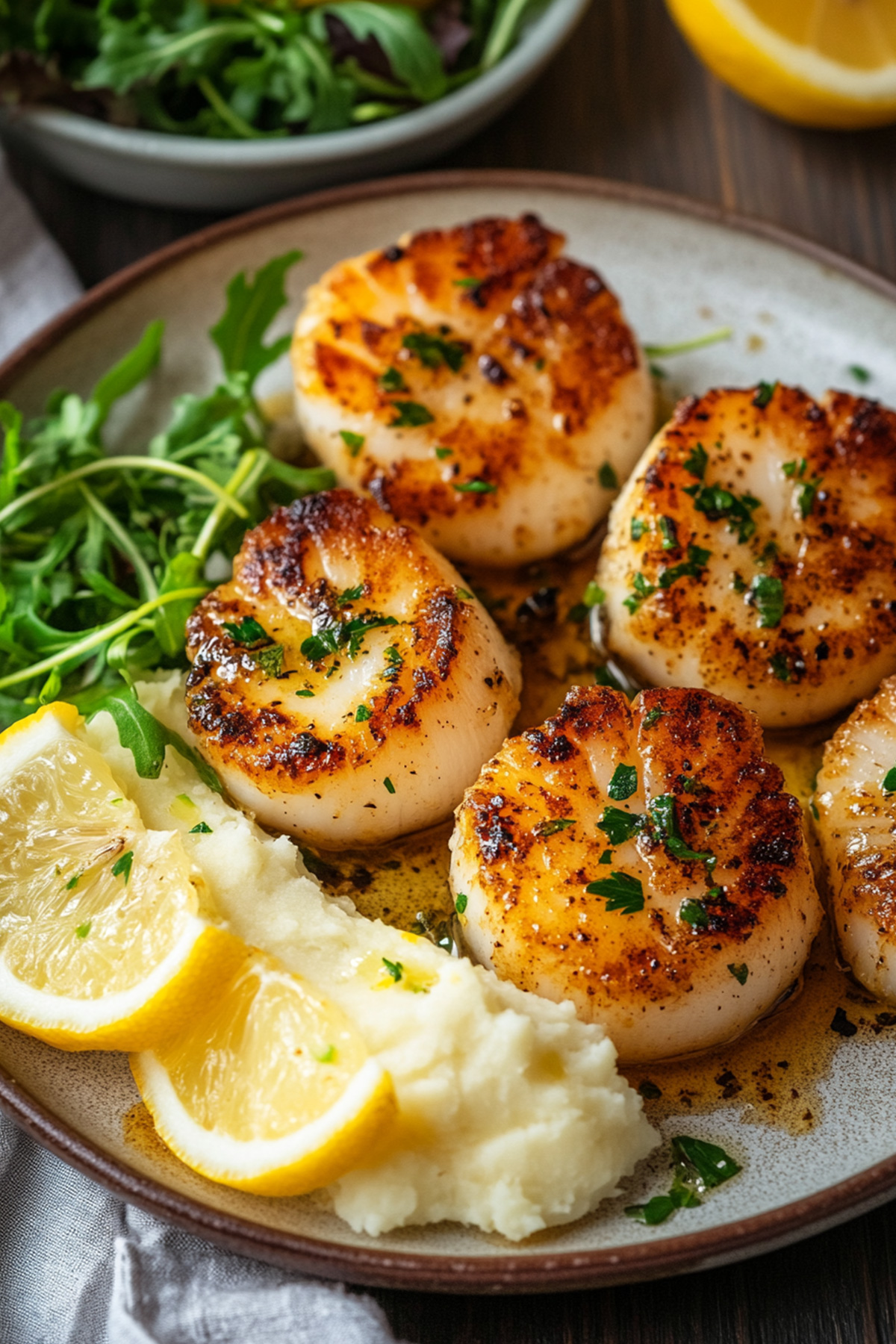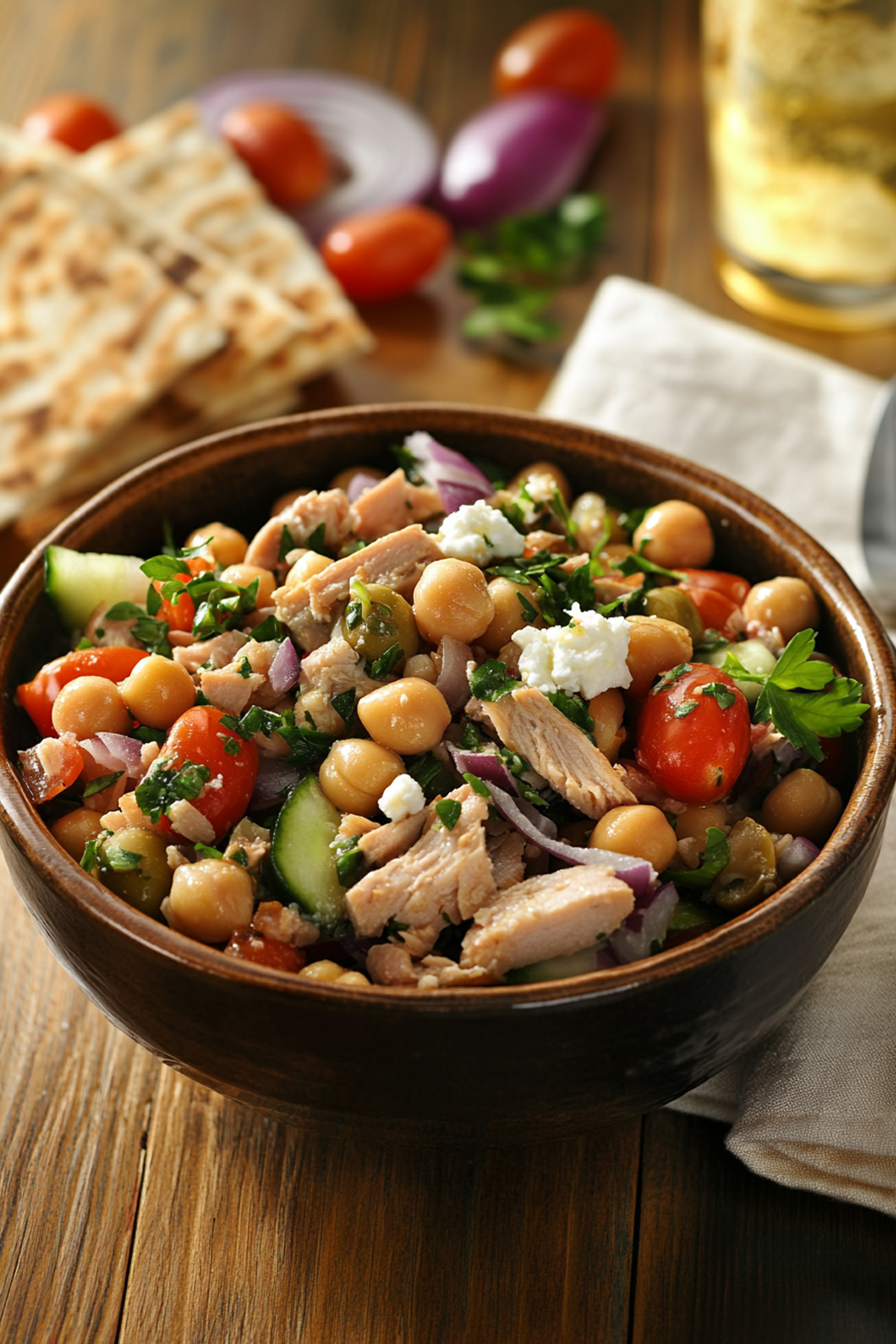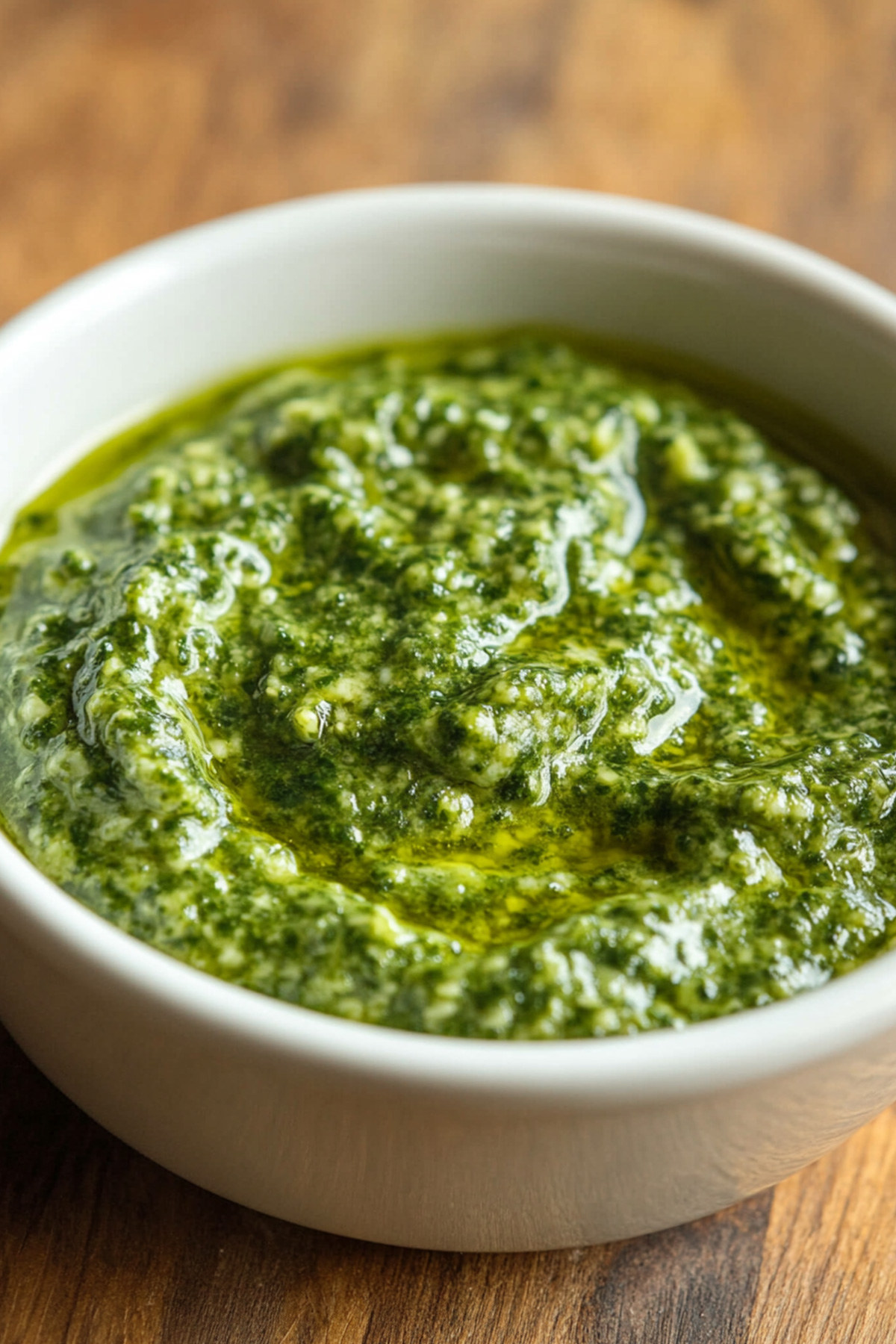Disclosure: As an Amazon Associate and participant in other affiliate programs, we earn from qualifying purchases. We only recommend products we believe will provide value to our readers.
A delicious twist on traditional Filipino sour soup awaits you with this salmon Sinigang recipe. The rich, tender salmon perfectly complements the signature tangy broth that makes Sinigang a beloved comfort food. Simple ingredients come together to create a warming, flavorful dish that suits any weather.
This piece shows you everything about Sinigang na ulo ng salmon and the classic salmon head Sinigang variation. The perfect Sinigang na salmon needs specific ingredients, careful preparation, and proper cooking techniques. Different souring agents and vegetable combinations let you create your own unique version of this cherished dish.
Table of Contents
What is Sinigang and Its Importance in Filipino Cuisine
Exploring Filipino cuisine reveals Sinigang as one of its most beloved dishes. This iconic sour and savory soup has become the life-blood of Filipino cooking, and TasteAtlas named it the world’s best vegetable soup in 2021.
Sinigang feels like a warm, comforting hug in a bowl. The distinctive tangy broth carries flavors that reflect generations of Filipino culinary heritage. This versatile dish brings satisfaction on harsh winter days and offers comfort on rainy afternoons.
The sort of thing I love about Sinigang is how adaptable it is. Traditional recipes use tamarind for sourness, but Filipino creativity has brought in other souring agents like:
- Fresh guava
- Green mango
- Calamansi
- Kamias
- Santol
Every Filipino household makes Sinigang, and each family adds their unique touch to the recipe. From Sinigang na salmon to other protein variations, this dish shows Filipino people’s resourcefulness and how they adapt while keeping their cultural identity.
Sinigang tells a story that’s complex, humbling, and deeply personal to Filipino culture. It’s more than just soup – it’s evidence of Filipino culinary innovation that brings families together at the dining table.
Why Choose Salmon for Sinigang?
Salmon stands out as an excellent choice for your Sinigang, and there are many reasons you’ll love this delicious fish. Ready in less than 30 minutes, this dish brings both convenience and nutrition to your table without sacrificing taste.
Salmon’s rich healthy fat content makes it a standout option that turns your Sinigang into a nutritious feast. The fish’s skin adds an extra texture dimension to your soup, and you won’t need to deal with troublesome scales.
Salmon’s versatility shines through in Sinigang preparation. The options include:
- Salmon filets for lean, meaty portions
- Salmon belly for rich, tender bites
- Salmon head for flavorful broth
- Salmon steaks for traditional serving
This comforting dish really hits the spot during cold or rainy weather. The hot, sour broth pairs perfectly with rich fish to create a warming, cozy meal. Salmon works beautifully with various vegetables – from traditional water spinach to modern additions like kale or watercress. You can experiment with seasonal produce while the authentic Sinigang taste remains intact.
What Makes Salmon Sinigang Different from Other Sinigang Varieties
Sinigang traditionally comes with pork or prawns, but salmon Sinigang brings something special to this Filipino favorite. Three key ingredients make this soup less fishy:
- Fresh radish
- Ginger
- Green chili
You can take your salmon Sinigang to new heights with Sinigang sa miso, which uses fermented soybean paste. The paste adds rich umami flavors that work beautifully with the salmon’s natural taste. Japanese white miso or traditional Filipino miso will both give your broth an amazing depth of flavor.
The story behind salmon Sinigang will surprise you – it started in Alaska! Filipino workers at canneries took their home recipe and made it work with what they could get locally. A simple need turned into something delicious, showing how great food often comes from working with available ingredients.
Salmon Sinigang shines because it’s so flexible. The flavor gets better when you mix different cuts of fish – try putting salmon belly and filets together for a richer broth. Fish sauce gives the soup its signature umami kick, creating that unforgettable taste Filipino food is known for.
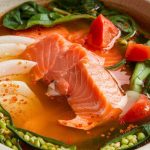
Salmon Sinigang Recipe
- Total Time: 25 minutes
Description
Want to make a perfect bowl of salmon Sinigang at home? This classic Filipino soup blends tender salmon and vegetables in a tangy broth that keeps people fed and soothes the soul.
This quick and easy salmon Sinigang comes together in less than 30 minutes. The recipe combines tender salmon cuts with fresh, crisp vegetables in a tangy broth that delivers the perfect balance of flavors. A delicious solution for busy weeknight dinners.
Ingredients
- 1½ lbs salmon (filet, belly, or head)
- 5 cups water
- 2 tablespoons tamarind powder/Sinigang mix
- 2 tablespoons fish sauce
- 1 thumb ginger, sliced
- 2 medium tomatoes, wedged
- 1 medium onion, quartered
- 1 medium daikon radish, sliced
- 5 pieces okra
- 3 pieces green chili peppers
- 1 bunch water spinach (kangkong)
Instructions
- Heat water in a large pot until it reaches a rolling boil over medium heat
- Drop tomatoes, onion, ginger, and radish into the pot and let them simmer for 5 minutes
- Lower the salmon pieces into the simmering broth with care
- Pour in the tamarind mix and fish sauce without stirring the contents
- Add okra and green chilies to the pot and cook everything for 3-5 minutes
- Toss in the water spinach and let it cook briefly for 30 seconds
- Remove the pot from heat and allow the dish to rest for 5 minutes
Notes
- Pro tip: Let the salmon settle in the pot before stirring to avoid any fishy smell
- A dash of miso paste at the end adds amazing depth to the flavor
- Choose between boiling or sautéing – both methods work great
- Prep Time: 10 minutes
- Cook Time: 15 minutes
- Category: Seafood
- Method: Steaming
- Cuisine: Asian
Tips for Preparing Salmon for Sinigang
Your sinigang’s success depends on how well you prepare the salmon. Here are the basic steps you need:
- Clean and pat dry each piece
- Season with salt and pepper
- Dust lightly with cornstarch
- Let rest for 5 minutes before cooking
The head is particularly prized in Sinigang, yet many cooks miss this opportunity. The cheeks and collar area hide tender, flavorful meat that adds depth to your dish. The broth becomes richer when you mix different cuts like belly and head in your soup.
A technique that will lift your Sinigang na salmon to new heights involves a quick step. Just fry the salmon’s head over medium-high heat until it develops a slight crust. This creates a beautiful golden exterior and keeps the fish intact during the simmering process.
Your Sinigang will taste amazing even if you can’t find every traditional cut – belly or filet pieces work great on their own. The secret lies in gentle handling and perfect timing. Salmon cooks fast, so add it at the perfect moment while preparing your Sinigang.
Read also: Dishwasher Salmon Recipe
The Best Souring Agents for Sinigang and How They Affect the Flavor
Creating that perfect tangy salmon Sinigang depends on your choice of souring agent. Tamarind (Sampalok) stands out as the top choice with its perfect balance of tartness and subtle sweetness. Yet you have several other options at your disposal.
Here are some alternative souring agents that create unique flavor profiles:
- Green mango – adds refreshing tropical zest
- Guava (Bayabas) – provides pleasant tartness
- Calamansi – perfect for seafood versions
- Kamias – delivers sharp sourness
- Batwan – popular in Western Visayas
Locals in the Visayas region prefer batwan to make their Sinigang. It brings a distinctive acidity that’s nowhere near as sharp as vinegar. The authentic, homemade taste comes from boiling fresh tamarind pods, and then mashing and straining the pulp to create your base. This approach gives your Sinigang na salmon a flavor that instant mixes can’t replicate.
Calamansi and kamias work exceptionally well in seafood versions like salmon Sinigang. These souring agents enhance the fish’s natural flavors without overwhelming them. The broth tastes clean and smooth once you strain out any seeds or unwanted bits after extracting the sour flavor.
You may like: How to Cook Fish Sinigang Recipe at Home
Common Vegetables for Sinigang and How to Choose the Freshest Ones
The perfect salmon Sinigang begins with the right vegetable selection. Traditional combinations create a symphony of textures and flavors that make this dish unique.
Your vegetable lineup should include:
- Water spinach (kangkong) – Look for crisp, bright green stems
- String beans (sitaw) – Choose firm, snap-fresh pods
- Eggplant – Select firm, glossy skinned ones
- Daikon radish – Pick smooth, heavy pieces
- Tomatoes – Choose ripe but firm ones
- Okra – Select small, bright green pods
- Long green peppers – Pick firm, unblemished ones
Pro tip: The vegetables’ perfect texture depends on their cooking sequence. Start by adding daikon radish and eggplant since they need more time to become tender. Add string beans and okra after 5 minutes. The water spinach goes in last, just before finishing – a quick wilt maintains its crisp texture.
Your Sinigang na salmon can adapt to modern alternatives when traditional vegetables aren’t available. Bok choy, regular green beans, or mustard greens work well as substitutes. Fresh, crisp vegetables that maintain their shape in the tangy broth make all the difference.
Onions and tomatoes serve a bigger purpose than just being vegetables in your Sinigang – they build the dish’s foundation. Onions add natural sweetness, while tomatoes contribute significant umami depth to your broth.
Cooking Techniques for an Authentic Salmon Sinigang Recipe
Become skilled at cooking your Sinigang na salmon with two proven techniques that create different flavor profiles in your soup.
The Classic Boiling Method This technique creates a lighter, clearer broth and lets your salmon’s natural flavors shine. The water should come to a gentle simmer. Add your aromatics (ginger, onions, and tomatoes) and let them infuse the broth for 5-7 minutes. A vital tip to remember with salmon pieces: avoid stirring the pot immediately after adding the fish. This prevents unwanted fishy smell from developing.
The Sauté Method The sauté technique creates a deeper, more intense flavor in your salmon Sinigang recipe:
- Heat oil in your pot until shimmering
- Sauté garlic until golden
- Add onions and tomatoes until softened
- Pour in your water and bring to a boil
- Carefully add your salmon pieces
- Add your souring agent and simmer
Your Sinigang na ulo ng salmon can reach new heights with miso paste added during the final minutes of cooking. This variation creates an extra layer of umami that enhances the tangy broth and tender salmon.
A gentle simmer works best throughout the cooking process. Aggressive boiling can break apart your salmon’s delicate pieces. The soup reaches perfection when the salmon cooks through and the vegetables become tender-crisp.
Regional Variations of Salmon Sinigang
The Philippines offers fascinating regional takes on Sinigang na salmon that highlight local ingredients based on regional priorities. Modern Filipino restaurants welcome this adaptability and create innovative versions that redefine the limits of tradition while staying true to the dish’s core.
Filipino cities showcase creative interpretations like:
- Watermelon-based Sinigang with a subtle sweetness
- Miso-enriched salmon Sinigang for extra umami
- White wine-infused versions adding sophisticated acidity
- Purple yam (ube) Sinigang for striking presentation
Northern regions typically use salmon filets in their recipes, while coastal communities love the salmon head version, known as Sinigang na ulo ng salmon. Each area adds its unique touch to the dish and sometimes uses local fruits as souring agents or adds vegetables unique to their region.
The salmon Sinigang you taste can differ by a lot between Filipino households. Many families enjoy a lighter, clearer broth, while others make it heartier by adding gabi (taro) for thickness. Contemporary versions maybe even mix different protein sources, especially when salmon shares space with shrimp or squid in seafood variations.
Tips for Serving Salmon Sinigang
These serving suggestions will elevate your salmon Sinigang into a perfect meal! The best way to enjoy this Filipino favorite is with a generous portion of steaming white rice served piping hot.
Traditional condiments can make your dining experience more exciting:
- Crushed spicy chili peppers with fish sauce
- Plain fish sauce (patis)
- Sautéed chili in fish sauce
- Whole green chilies on the side
A special serving tip will make your Sinigang na salmon taste even better. Simply prepare a small saucer of crushed chilies mixed with fish sauce as your dipping sauce. This combination enhances the sour broth and tender fish perfectly.
Your salmon Sinigang will taste fantastic even if you’re missing some vegetables. The dish only needs its sour base, tomatoes, and one or two other vegetables. This recipe’s flexibility makes it truly special.
To create the ultimate comfort food experience, serve your hot bowl of salmon Sinigang when it’s cold or rainy outside. Spicy and sour flavors combine to create a cozy meal that chases away winter blues. Note that the soup needs a few minutes to rest after cooking, which allows the flavors to blend perfectly before serving.
How to Store and Reheat Leftover Salmon Sinigang
Proper storage techniques will keep your Sinigang na salmon fresh and flavorful. Quick and careful storage after cooking preserves this delicious dish’s authentic taste.
Storage Guidelines
Your salmon Sinigang needs to cool down to room temperature naturally. The dish should not sit out longer than two hours. An airtight container will keep it fresh and protect it from unwanted fridge smells. Here’s everything about storing your Sinigang:
- Label containers with the date
- Store in the back of the fridge (coldest spot)
- Keep vegetables and broth together
- Use within 3-4 days
Reheating Instructions
Ready to enjoy your leftover Sinigang? Here’s how to get the best results:
- Take your desired portion and pour it into a pot
- Place it over medium heat and stir occasionally
- Let the soup reach a gentle simmer
- Continue heating until the temperature hits 165°F
- Your soup might need fresh vegetables – add them now
Safety Tips
Trust your senses as you check if your Sinigang remains safe to eat. Your soup has spoiled if you notice unusual sourness beyond its natural tang, small bubbles floating on top, or a slimy texture. The broth can last longer if you freeze it separately from the vegetables. This method works better with meat-based Sinigang than its salmon counterpart.
Frequently Asked Questions about Salmon Sinigang
Curious about your Sinigang na salmon? Let me answer some common questions that will help you make this Filipino favorite even better!
Can I make a vegan version of salmon Sinigang?
You can definitely make this dish vegan! The best approach is to replace fish sauce with soy sauce or vegan fish sauce and use crispy seared tofu instead of salmon. Extra vegetables will keep that hearty, satisfying texture.
Is salmon Sinigang healthy?
This dish packs quite a nutritious punch! The salmon provides omega-3 fatty acids and vitamin D, while the broth comes loaded with vegetables. The combination creates a balanced meal that nourishes and comforts you.
Do I need to sauté the ingredients first?
Sautéing aromatics creates more depth in flavor, but you can skip this step when time is tight. Many people just put everything in the pot at once and still end up with delicious results.
Where can I find affordable salmon heads for Sinigang?
Your local sushi restaurants or seafood markets might help. These places often discard salmon heads and could give them away free or sell them at reduced prices.
Can I add miso to my salmon Sinigang?
Miso works great in this dish! Japanese white miso or any mild miso paste adds wonderful umami flavor. Just remember to stir it in right before you turn off the heat.
Is Filipino Sinigang typically spicy?
Traditional Sinigang stands apart from other Southeast Asian soups because it isn’t naturally spicy. You can customize the heat level by adding as many green chilies as you like.
Conclusion
Salmon Sinigang showcases Filipino culinary state-of-the-art by combining traditional cooking methods with modern adaptability. This beloved dish proves that authentic flavors don’t need complexity. Simple ingredients create a satisfying meal that honors cultural heritage and welcomes personal interpretation. The tender salmon’s combination with fresh vegetables and signature sour broth creates a harmonious balance that Filipino tables worldwide have embraced.
Home cooks can explore endless possibilities with salmon Sinigang by selecting different souring agents and adding regional variations. Both novice cooks and experienced chefs appreciate this dish’s forgiving nature, and its nutritional benefits appeal to health-conscious food lovers. Salmon Sinigang, whether prepared with classic tamarind or modern alternatives, remains evidence of Filipino comfort food’s enduring appeal.

